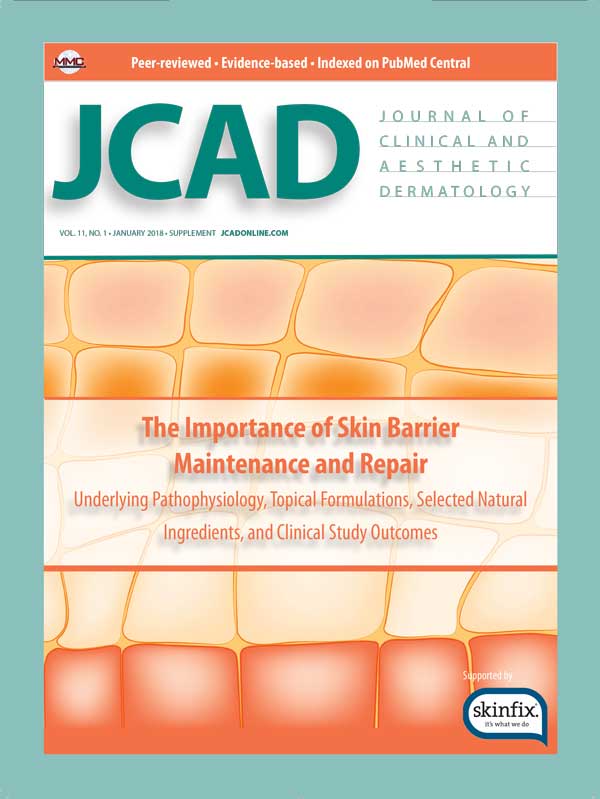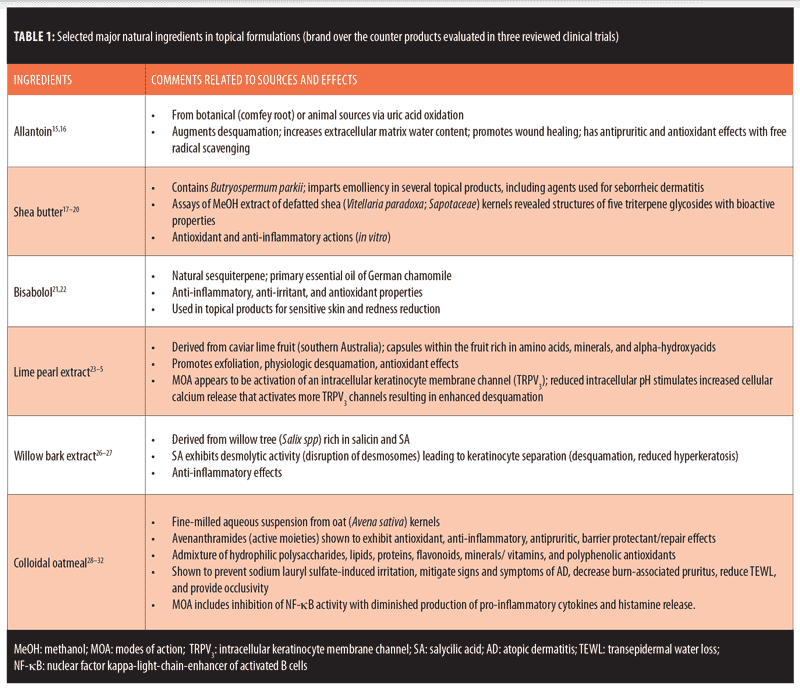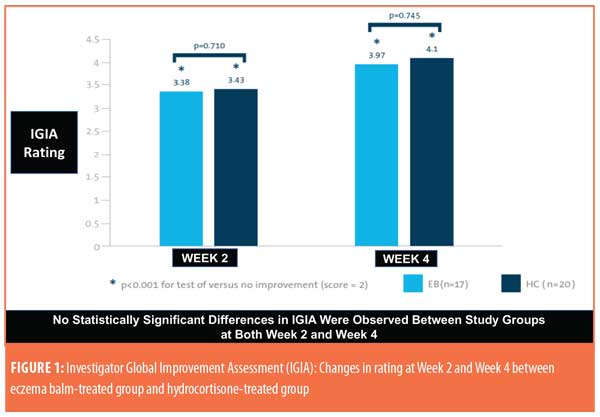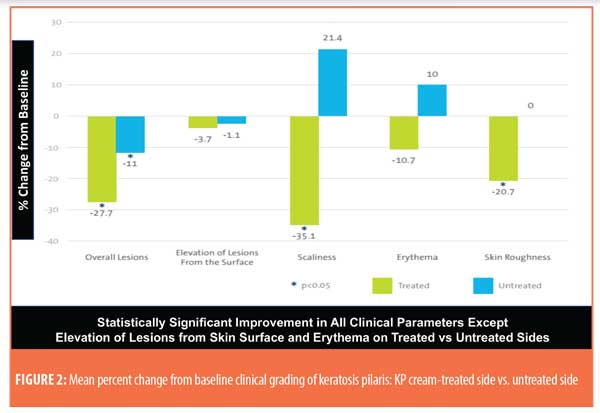This JCAD supplement is supported by Skinfix®

by Neal Bhatia MD; James Q. Del Rosso DO; Joshua Zeichner MD; and Brian Berman MD, PhD
Dr. Bhatia is with Therapeutics Clinical Research in San Diego, California. Dr. Del Rosso is with JDR Dermatology Research and Thomas Dermatology in Las Vegas, Nevada. Dr. Zeichner is with the Icahn School of Medicine at Mount Sinai in New York, New York. Dr. Berman is with the Center for Clinical and Cosmetic Research in Aventura, Florida, and the University of Miami in Miami, Florida.
Funding: Funding for this article was provided by Skinfix Inc. (Halifax, Nova Scotia)
Disclosures: Dr. Bhatia is a consultant and advisory board member for Skinfix Inc., Halifax, Nova Scotia. Dr. Del Rosso served as a consultant and writer for this supplement.
Dr. Zeichner is a consultant and advisory board member for Skinfix Inc., Halifax, Nova Scotia. Dr. Berman is an advisory board member for Skinfix Inc., Halifax, Nova Scotia.
J Clin Aesthet Dermatol. 2018;11(1 Suppl):S3–S8
Introduction
Over the past several years, clinicians have come to appreciate the therapeutic value of using adjunctive skin care to maintain the structural and functional integrity of the epidermal barrier. Proper skin care is vital for the maintenance of healthy skin and in the management of a wide variety of cutaneous disorders.1 A pivotal role of the epidermal barrier is maintenance of physiologic water flux, including optimal water content and gradient within the stratum corneum (SC), which is required to sustain single-cell desquamation, improve skin elasticity, and preserve smooth surface texture.1–3 When water content within the SC is inadequate due to increased transepidermal water loss (TEWL), the activity of key epidermal enzymes involved in maintaining SC structure and function are reduced leading to adverse sequelae that manifest both visibly and symptomatically.1–3
Many adverse changes occur in association with an uncorrected increase in TEWL and suboptimal SC enzyme function, both of which lead to xerotic and eczematous skin changes. These sequelae include increased skin rigidity with development of microfissuring and macrofissuring, abnormal desquamation with resultant scaling and flaking, triggering of cytokine release with production of inflammation, and epidermal thickening, which can cause hyperkeratosis and fissures.1–3 Importantly, other activities of the SC, such as the antimicrobial barrier, can also be adversely affected by epidermal barrier dysfunctions secondary to increased TEWL.1,4
Topical Formulations and Ingredient Selection for Management of Healthy and Diseased Skin
The continued increase in information on normal epidermal barrier activity and implications of dysfunctions has uncovered functional and structural SC impairments present in a variety of common skin conditions, including xerosis, atopic dermatitis (AD), acne vulgaris (AV), rosacea, and psoriasis vulgaris, and with some therapies such as topical corticosteroids (TCS).1,3,5–10 These barrier dysfunctions appear to correlate with clinical manifestations of several skin disorders.1 Managing SC impairment and increased TEWL has been shown to be clinically relevant by contributing to disease improvement, reduction in the amount and/or duration of TCS use in AD, and to reduced signs and symptoms of cutaneous irritation associated with topical agents used to treat AV and rosacea.1,11–14
The terms “natural” and “organic” are used very commonly, and often loosely, when describing selected ingredients in topical formulations. It is the perception of whether the ingredients are synthetic or harvested from a botanical or other organic source that often leads to the “natural” approach being inherently preferred by many patients. They often sense that natural ingredients have been used historically with favorable results and apparent safety. In fact, many ingredients that can be derived or extracted from natural sources appear to exhibit properties that support various barrier functions within the epidermis. When it comes to maintaining healthy skin, managing xerosis, and treating common skin conditions, such as eczematous dermatoses, there needs to be a more comprehensive understanding of how specific ingredients that are considered to be natural can facilitate epidermal barrier restoration or provide other benefits, such as anti-pruritic or antimicrobial effects.
This article reviews ingredients used in selected topical formulations within a designated over-the-counter (OTC) skin care product line (Skinfix, Inc., Halifax, Nova Scotia) and presents data from three clinical studies evaluating individual products specifically formulated to target the management of common skin conditions (e.g., atopic dermatitis/eczematous dermatitis, keratosis pilaris, hand xerosis/dermatitis).
Evaluation of Ingredients Used in Designated OTC Topical Formulations
The three topical formulations evaluated in the clinical studies we describe in this article incorporate selected ingredients that appear to provide specific modes of action (MOAs) helpful in the management of certain skin conditions (see clinical data section). All three of the topical formulations discussed are nonsteroidal, parabens-free, fragrance-free, phthalate-free, and lanolin-free. Table 1 depicts some of the major ingredients used and their purported clinical effects, including allantoin, shea butter, bisabolol, lime pearl extract, willow bark extract, and colloidal oatmeal.15–32 A variety of natural oils are also used in some formulations to improve skin texture and provide emollience and occlusivity (e.g., jojoba oil, soybean oil, sweet almond oil).23 Sweet almond oil contains fatty acids (e.g., linoleic acid, palmitic acid, oleic acid) that can provide emollience.

Designated OTC topical formulations in common dermatologic disorders: Results of three clinical studies. Study 1: Atopic dermatitis /eczematous dermatitis. An OTC anhydrous balm formulated for use in eczema-prone and eczema-affected skin was evaluated in adult subjects with atopic dermatitis or eczematous dermatitis (AD/ED).33 The major ingredients of the balm formulation, referred to as eczema balm (EB; Skinfix Eczema Balm), are zinc oxide, colloidal oatmeal, allantoin, sweet almond oil, shea butter, soybean oil, jojoba oil, beeswax, petrolatum, paraffin, and tocopherol.
Objective. The objective of this study was to compare the efficacy and safety of EB versus hydrocortisone 1% cream (HC 1%) in adult subjects with mild or moderate AD/ED.33
Methodology. The study was a double-blind, single-center, randomized (1:1), controlled, four-week clinical trial. Subjects (N=37) applied a sufficient quantity of either EB (n=17) or HC 1% (n=20) twice daily to all areas affected with AD/ED and surrounding skin. Application was to be completed in the morning and evening to dry skin, especially after prior bathing. Subjects were evaluated at baseline, Week 2, and Week 4.
Enrolled subjects. This study included adults (age range 18–65 years; mean age 45.9 years) of both sexes (75.7% female) with the following: Fitzpatrick Skin type I to IV (75.7% Caucasian); clinically evident mild or moderate AD/ED (defined by >10% total body surface area [BSA] affected); presence of at least one active AD/ED lesion; and SCORing Atopic Dermatitis (SCORAD) value less than 50. Thirty-eight subjects were enrolled; 37 completed the study (1 EB subject chose to withdraw). Seventeen subjects used EB and 20 used
HC 1%.
Assessments. Efficacy assessments at each study time point were SCORAD and Investigator Global Improvement Assessment (IGIA ranked 1 [worse] to 5 [markedly improved]). The following were also assessed and tabulated independently with changes evaluated as compared to baseline at each study visit: A=Area Scores (BSA affected); B=Intensity Scores (erythema, swelling, oozing/crusting, excoriations, lichenification, dryness); and C=Subjective Symptom Scores (pruritus, sleeplessness). Quality-of-life (QoL) was evaluated using Dermatology Life Quality Index (DLQI). TEWL was assessed using a target lesion selected by a board-certified dermatologist investigator. TEWL measurements were completed under standardized conditions of acclimation and controlled temperature/humidity using triplicate Tewameter measurements. Safety evaluations included capturing of cutaneous tolerability parameters of erythema, dryness/scaling, peeling, edema, burning, stinging, tightness, and tingling using a 5-point scoring scale (0=none, 1=mild, 2=moderate, 3=severe).
Efficacy outcomes. Overall, no significant differences were noted between both study groups in efficacy. Based on IGIA (Figure 1) and assessments of Area Affected (A), Intensity (B), Subjective Symptoms (C), and overall SCORAD results (Table 2), EB resulted in marked decreases from baseline in the signs and symptoms of AD/ED, with nearly all changes in clinical features achieving statistical significance within two weeks and sustained throughout Week 4. There were no significant differences versus HC 1% for nearly all measures. HC 1% did produce significantly greater reductions in exudation and excoriation versus EB at Week 2 and in sleeplessness at Weeks 2 and 4. EB significantly decreased TEWL at Week 2 and Week 4 while HC 1% produced a significant reduction only at Week 2. This latter finding might be explained by EB more directly improving SC barrier function with resultant reduction in inflammation as compared to HC 1% reducing TEWL primarily via the anti-inflammatory activity of the TCS (hydrocortisone).


Safety outcomes. No adverse events (AEs) to either study medications were observed over the study duration. Statistically significant reductions in all cutaneous tolerability parameters were noted as compared to baseline (p<0.05) with no significant differences observed between study groups (p>0.05).
QoL outcomes. Overall, the DLQI responses exhibited no significant differences in response at both follow-up time points (p>0.05).
Author commentary on clinical relevance. This study demonstrated that application of Eczema Balm effectively and safely reduces signs and symptoms of mild and moderate AD/ED with results comparable to a low potency TCS (hydrocortisone). EB may be incorporated to assist in flare reduction of AD/ED and as a component of maintenance therapy between flares in patients with atopic skin and in those with phenotypically xerotic skin who are prone to eczematous dermatitis.
Study 2: Keratosis pilaris. Keratosis pilaris (KP) is a common chronic, refractory skin disorder seen in children, adolescents, and adults. KP presents as small focal keratotic papules with varying degrees of perifollicular erythema, and is often associated with atopic skin; sites of predilection are the face, buttocks, posterior-lateral arms, and anterior thighs.34 An OTC cream, formulated using multiple natural ingredients for treatment of KP (KP cream; Skinfix Renewing Cream), was evaluated in adult subjects with mild or moderate KP symmetrically affecting the arms or thighs.23 The major ingredients of the KP cream are lime pearl extract (source of alpha-hydroxy acids), willow bark extract (source of salicylic acid), bisabolol, shea butter, and natural emollient oils.
Objective. The objective of the study was to evaluate the efficacy of KP cream in adult subjects with KP involving the arms or thighs.23
Methodology. The study was a single-center, randomized, investigator-blinded, split-body (subject as own control), two-week trial. KP cream was randomly assigned for twice daily application to one side (arm or thigh) affected with KP with the alternate KP-affected side remaining untreated. Study assessments were completed at baseline and Week 2. Subjects were instructed to apply a dime sized amount of KP cream to one assigned treatment site twice daily (morning and evening) for two weeks. The alternate symmetric site remained untreated over the duration of the study.
Enrolled subjects. This study enrolled adults (age range 18–60 years; mean age 34.7 years) of both sexes (90% female) with clinically evident mild or moderate KP with symmetric involvement of arms or thighs (N=30). Subjects with severe erythema in the treatment area at baseline were excluded. Thirty-one subjects were enrolled with one subject withdrawing for reasons unrelated to study treatment.
Assessments. At baseline and end of study (Week 2), the symmetric study sites were independently evaluated by two board certified dermatologist investigators. Visual evaluations were conducted for overall lesions (goose-bumpy skin), elevation of lesions from surface, extent of scaling, erythema, and skin texture (roughness) at each designated site utilizing a 4-point scale. At Week 2, a questionnaire was completed by all study subjects.
Study outcomes. Clinical grading of study parameters showed that KP cream produced statistically significant improvements from baseline in overall lesions (p<0.001), scaliness (p=0.027), and skin roughness (p=0.006); no significant improvements were noted in elevation of lesions from the surface or in erythema. The untreated side experienced a significant decrease in overall lesions from baseline (p=0.011) but no improvements were observed in other parameters (Figure 2). KP cream produced significantly greater improvements from baseline compared to no treatment in overall lesions (p=0.004), scaliness (p=0.003), and skin roughness (p=0.012), with no significant differences observed in elevation of lesions or in erythema between sides (Figure 2). No safety concerns or AEs were reported during the study. The majority of subjects (60-80%) reported statistically significant favorable outcomes, with KP cream decreasing skin roughness/bumpiness (p<0.001 – p=0.010) and soothing pruritic skin (p<0.001).

Author commentary on clinical relevance. KP is often persistent, subject to periods of increased spiny focal hyperkeratosis, and is notoriously refractory to many different topical treatments. This study supports effective and safe use of an OTC topical cream specifically formulated for use in KP. The OTC study cream decreased the tactile roughness/bumpiness on the arms and thighs within two weeks based on independent evaluations by dermatologist investigators and study subjects.
Study 3: Moderate-to-severe hand xerosis/history of chronic hand dermatitis. This was a single-center, open-label, uncontrolled, one-week study that included adult subjects (N=35) with moderate-to-severe hand xerosis, characterized by dryness and cracking, with a history of chronic hand dermatitis including from occupational causes.35 The objective of this study was to evaluate whether a moisturizer cream containing sweet almond oil 7% and colloidal oatmeal 2% (HR cream; Skinfix Hand Repair Cream) could alleviate the associated signs and symptoms.
Methodology. Subjects applied HR cream at least three times per day to the hands, with avoidance of hand washing, touching, wiping, or toweling of hands for at least 15 minutes after application. At baseline, prior to application, signs and symptoms of disease severity and corneometry readings were captured on the dorsal hands. The first dose of HR cream was applied under supervision, with a second corneometry reading performed 15 minutes after application. All participants completed daily study diaries. At Week 1 (end of study), Global Improvement Assessment (GIA) scores were recorded, individual signs and symptoms of disease were assessed, corneometry testing was repeated, and safety and tolerability were evaluated.
Enrolled subjects. Thirty-six subjects with moderate or severe xerosis and a history of chronic hand dermatitis were enrolled.35 One subject discontinued early due to reasons unrelated to study medication. The mean subject age was 42.9 years, with the majority female (57.1%) and Caucasian (74.3%). Conventional inclusion and exclusion criteria methods were incorporated.
Assessments. The primary efficacy parameter was the GIA score comparison to baseline (6-point scale: 0=moderate or greater worsening, 1=slight worsening, 2=no change, 3=slight improvement, 4=moderate improvement, 5=marked improvement). Individual signs of scaling, cracking, erythema, dryness, and pruritus were assessed using a 10-point rating scale (0=clear, 1–3=mild, 4–6=moderate, and 6–9=severe). Corneometry measurements were completed as described above. Safety outcomes included documentation of any AEs and adverse changes related to skin tolerability, including application site reactions.
Study outcomes. All subjects experienced global improvement at Week 1. The average GIA score across both hands at Week 1 was 4.40, with a score of 4 defined as moderate improvement and a score of 5 defined as marked improvement compared to baseline (P<0.001). Mean GIA scores were 4.40 for both the left hand (P<0.001) and right hand (P<0.001); the minimum recorded GIA score was 3 (slight improvement) and the maximum score was 5 (marked improvement). Individual signs of scaling, cracking, erythema, and dryness, and the symptom of pruritus all showed statistically significant improvements after one week compared to baseline (p<0.001). Average severity score percent reductions in dryness, scaling, skin cracking, erythema, and pruritus were 76.1, 75.7, 92.0, 61.0, and 88.3 percent, respectively. Marked improvements in corneometry readings were noted after application of HR cream at both the 15 minute post-baseline and Week 1 measurements. Significant corneometry improvements were observed in 91.4 percent of subjects at Week 1, with a mean increase of 110.9 percent versus baseline (both hands average, p<0.001). Satisfaction with HR cream after one week of use was reported based on individual assessment questions in 80 to 90 percent of subjects. For example 80 percent reported that HR cream worked quicker and more effectively than other previously used products, and 80 percent noted that HR cream healed their hand eruption. HR cream was well tolerated with no worsening of stinging, tightness, or tingling of the skin; 2.9 percent noted worsening of burning sensation.
Author commentary on clinical relevance. This study demonstrates that HR cream is beneficial in reducing signs and symptoms associated with chronic xerosis of the hands that is moderate to severe in intensity, including patients with a history of chronic hand dermatitis. This is likely to offer the additional benefit of reducing the common reflex to apply a TCS, even when clinical manifestations are predominantly xerotic in nature with minimal visible inflammation. The efficacy results suggest that the combination of sweet almond oil and colloidal oatmeal collectively provide barrier protectant, anti-inflammatory, and anti-pruritic effects. HR cream is adaptable for long term use.
References
- Del Rosso JQ, Levin J. The clinical relevance of maintaining the functional integrity of the stratum corneum in both healthy and disease-affected skin. J Clin Aesthet Dermatol. 2011;4(9):22–42.
- Elias PM. The epidermal permeability barrier: from Saran Wrap to biosensor. In: Elias PM, Feingold KR, eds. Skin Barrier. New York: Taylor & Francis; 2006:25–32.
- Harding CR. The stratum corneum: structure and function in health and disease. Dermatol Ther. 2004;17:6–15.
- Braff M, Di Nardo A, Gallo RL. Keratinocytes store the antimicrobial peptide cathelicidin in lamellar bodies. J Invest Dermatol. 2005;124:94–100.
- Cook M, Danby SG, Vasilopoulos Y, et al. Epidermal barrier dysfunction in atopic dermatitis. J Invest Dermatol. 2009;129:1892–1908.
- Dirschka T, Tronnier H, Fölster-Holst R. Epithelial barrier function and atopic diathesis in rosacea and perioral dermatitis. Br J Dermatol. 2004;150:1136–1141.
- Yamamoto A, Takenouchi K, Ito M. Impaired water barrier function in acne vulgaris. Arch Dermatol Res. 1985;287:214–218.
- Ghadially R, Reed JT, Elias EM. Stratum corneum structure and function correlates with phenotype in psoriasis. J Invest Dermatol. 1996;107(4):558–564.
- Kao JS, Fluhr JW, Man MQ, et al. Short-term glucocorticoid treatment compromises both permeability barrier homeostasis and stratum corneum integrity: inhibition of epidermal lipid synthesis accounts for functional abnormalities. J Invest Dermatol. 2003;120:456–464.
- Hong SP, Oh Y, Jung M, Choi EH. Topical calcitriol repairs epidermal permeability and antimicrobial barriers induced by corticosteroids. Br J Dermatol. 2010;162: 1251–1260.
- Boguniewicz M. Conventional topical treatment of atopic dermatitis. In: Bieber T, Leung DYM, eds. Atopic Dermatitis. New York: Marcel Dekker; 2002:453–477.
- Chamlin SL, Kao J, Frieden IJ, et al. Ceramide-dominant barrier repair lipids alleviate childhood atopic dermatitis: changes in barrier function provide a sensitive indicator of disease activity. J Am Acad Dermatol. 2002;47:198–208.
- Thiboutot D, Del Rosso JQ. Acne vulgaris and the epidermal barrier: is acne vulgaris associated with inherent epidermal abnormalities that cause impairment of barrier functions? do any topical acne therapies alter the structural and/or functional integrity of the epidermal barrier? J Clin Aesthet Dermatol. 2013;6(2):18–24.
- Del Rosso JQ. The use of moisturizers as an integral component of topical therapy for rosacea: clinical results based on the assessment of skin characteristics study. Cutis. 2009;84:72–76.
- Veraldi S, De Micheli P, Schianchi R, Lunardon L. Treatment of pruritus in mild to moderate atopic dermatitis with a non-steroidal agent. J Drugs Dermatol. 2009;8(6):537-539.
- Paller AN, Nardi R, Do H, et al. An investigation into multifaceted mechanisms of action of allantoin in wound healing. J Am Acad Dermatol. 2017;76(6 Suppl 1):AB40.
- Bhatia N. Treating seborrheic dermatitis: review of mechanisms and therapeutic options. J Drugs Dermatol. 2013;12(7):611-613.
- Maranz S, Wiesman Z, Bisgaard J, Bianchi G. Germplasm resources of Vitellaria paradoxa based on variations in fat composition across the species distribution range. Agroforestry Systems. 2004;60:71.
- Essengue Belibi S, Stechschulte D, Olson N. The use of shea butter as an emollient for eczema. J Allergy Clin Immunol. 123(2):S41.
- Zhang J, Kurita M, Shinozaki T, et al. Triterpene glycosides and other polar constituents of shea (Vitellaria paradoxa) kernels and their bioactivities. Phytochemistry. 2014;108:158–170.
- Braga PC, Dal Sasso M, Fonti E, Culici M. Antioxidant activity of bisabolol: inhibitory effects on chemoluminescence of human neutrophil bursts and cell-free systems. Pharmacology. 2009;83(2):110–115.
- Draelos ZD. Facial redness. In: Draelos ZD, ed. Cosmeceuticals, 3rd ed. Philadelphia: Elsevier; 2016:167–169.
- Donald A, Rozanski R. Efficacy and consumer perception of a 96% natural cream containing lime pearl extract and willow bark extract when used by subjects with clinically determined keratosis pilaris. Poster presentation. Fall Clinical Dermatology. 12–15 October 2017. Las Vegas, Nevada. SKIN The Journal of Cutaneous Medicine, 2017;1. DOI: 10.25251/skin.1.supp.67.
- Loing E, Begin-Lavallée B. Caviar lime AHAs for novel TRPV3 action and exfoliating benefits. Cosmet Toilet. 2014;1–6.
- Vogt-Eisele AK, Weber K, Sherkheli MA, et al. Monoterpenoid agonists of TRPV3. Brit J Pharmacol. 2007;151:530–540.
- Leveque J, Saint-Leger D. Salicylic acid derivatives. In: Leyden JJ, Rawlings AV, eds. Skin Moisturization. New York: Marcel-Dekker;2002;353–364
- Fiebich BL, Appel K. Anti-inflammatory effects of willow bark extract. Clin Pharmacol Ther. 2003; 74:96.
- Ilnytska O, Kaur S, Chon S, et al. Colloidal oatmeal (Avena sativa) improves skin barrier through multi-therapy activity. J Drugs Dermatol. 2016;15(6):684–90.
- Reynertson KA, Garay M, Nebus J, et al. Anti-inflammatory activities of colloidal oatmeal (Avena sativa) contribute to effectiveness of oats in treatment of itch associated with dry, irritated skin. J Drugs Dermatol. 2015;14(1):43–48.
- Vie, K, Cours-Darne S, Vienne MP, et al. Modulating effects of oatmeal extracts in the sodium lauryl sulfate skin irritancy model. Skin Pharmacol Appl Skin Physiol. 2002;15(2):120–124.
- Cerio R, Dohil M, Jeanine D, et al. Mechanism of action and clinical benefits of colloidal oatmeal for dermatologic practice. J Drugs Dermatol. 2010. 9(9):1116–1120.
- Sur R Nigam A, Grote D, et al. Avenanthramides, polyphenols from oats, exhibit anti-inflammatory and anti-itch activity. Arch Dermatol Res. 2008;300(10):569–574.
- Kurtz ES, Wallo W. Colloidal oatmeal: history, chemistry and clinical properties. J Drugs Dermatol. 2007;6(2):167–170.
- Donald A, Babcock M. Comparison of an anhydrous OTC balm containing 15% zinc oxide, 2% colloidal oatmeal, and 1% allantoin versus 1% hydrocortisone cream in subjects with mild to moderate dermatitis. Poster presentation. Fall Clinical Dermatology. 12–15 October 2017. Las Vegas, Nevada.
- Habif TP. Keratosis pilaris. In: Habif TP, ed. Clinical Dermatology, Sixth Edition. Philadelphia: Elsevier; 2016:163–164.
- Donald A, Babcock M. Efficacy and tolerability of an OTC cream when used by subjects with clinically determined moderate to severe xerosis on the hands. Poster presentation. Winter Clinical Dermatology. 13–18 January 2017. Kohala Coast, Hawaii.

